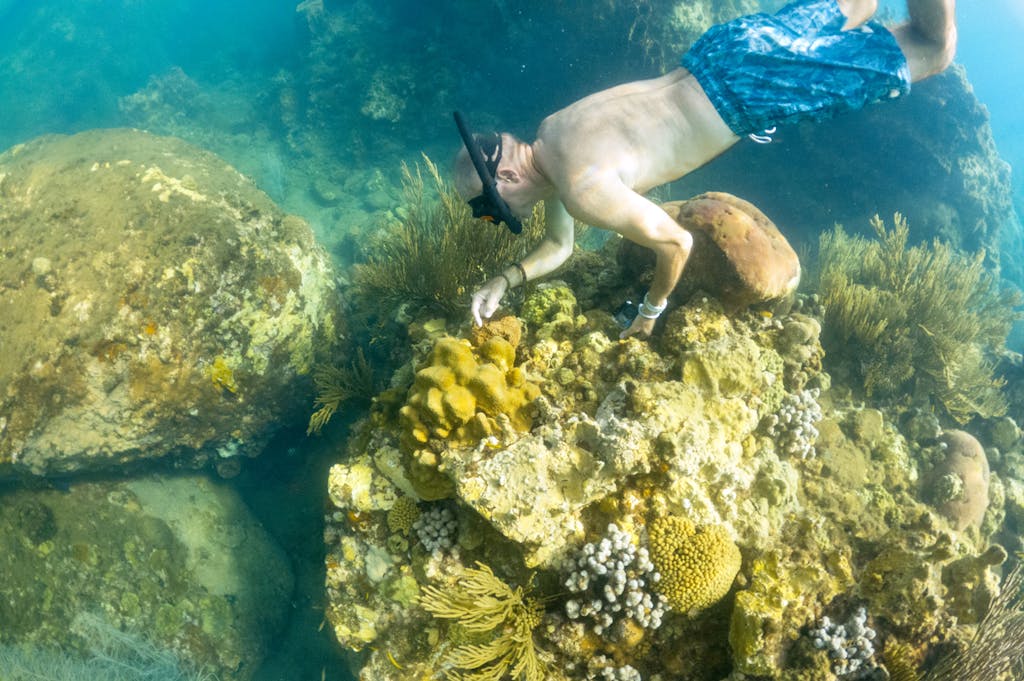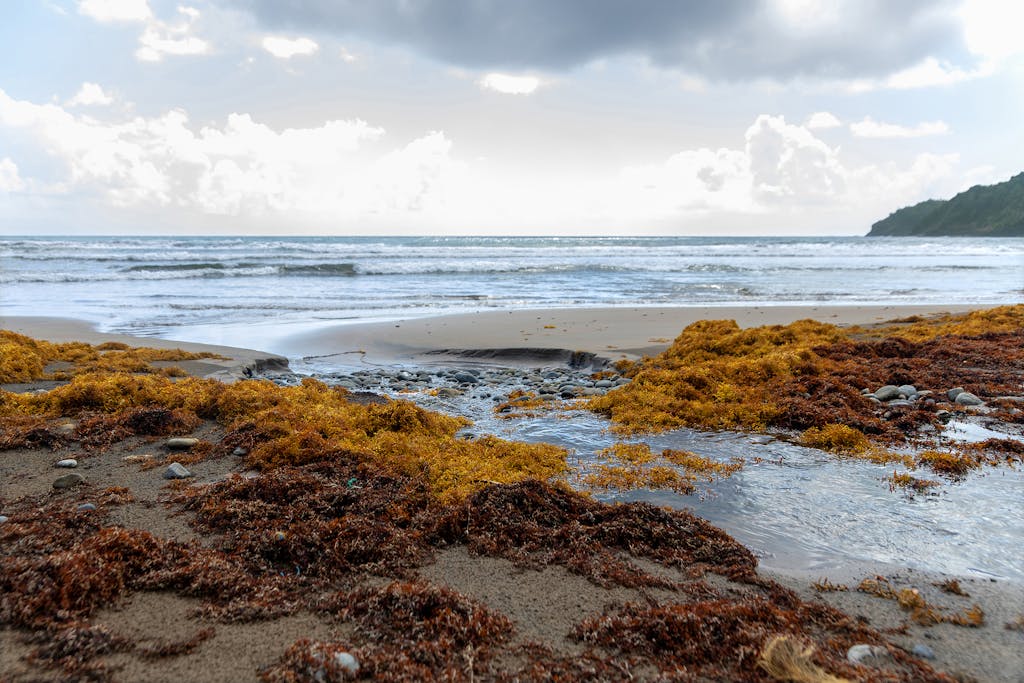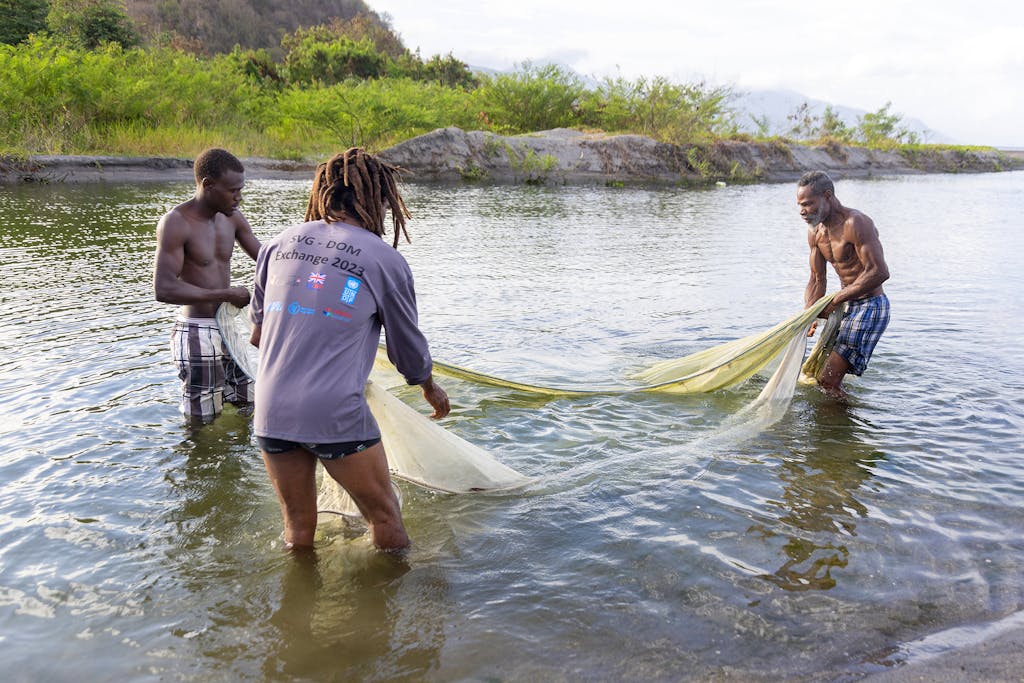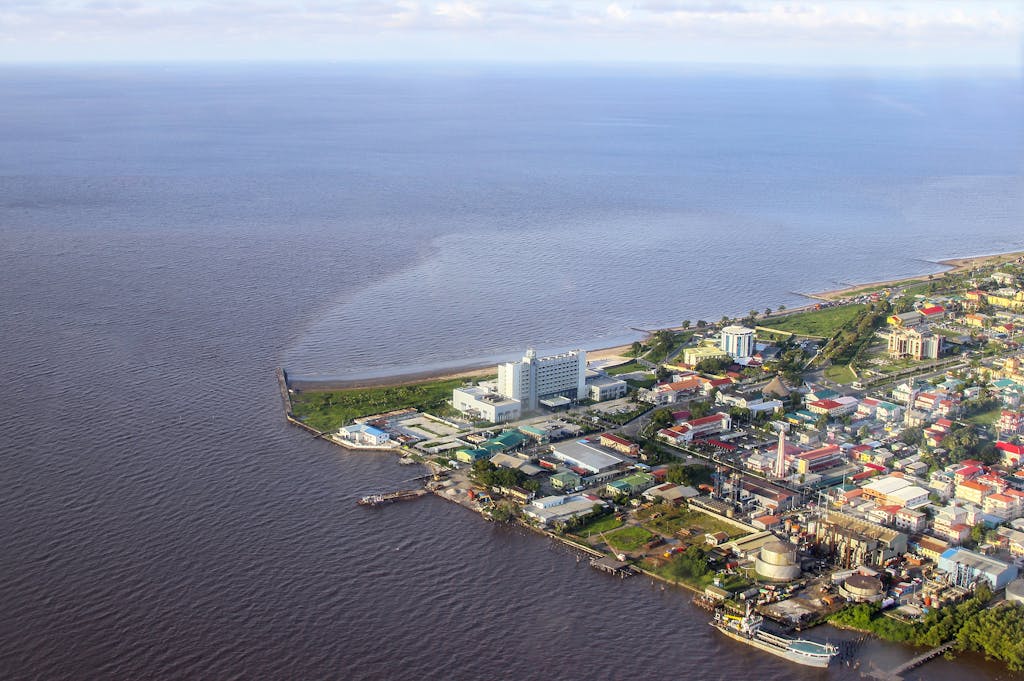
A critically endangered species of sea turtle swims through a dome-shaped artificial reef nicknamed “the igloo” that is helping to reestablish coral nurseries in the Red Sea. This image won the UN World Oceans Day Photo Competition in 2023. Photo: Tom Shlesinger
As greenhouse gases continue to be pumped into the atmosphere, our ocean is rapidly deteriorating. Yet when it comes to climate action, protecting the planet’s biggest ecosystem remains overlooked and underfunded. In response, the UN is renewing ambition to accelerate climate-ocean action — including through the Ocean Decade and Sustainable Development Goals — before it’s too late.
The ocean appears to be reaching a tipping point. For the past year, sea surface temperatures have shattered records daily. Ninety percent of the globe’s big fish populations are depleted. Half of the coral reefs are destroyed. The triple planetary crisis of climate change, pollution, and biodiversity loss is pushing Earth, especially life below water, to the brink of extinction.
“The consequences are becoming unignorable,” says Jessie Turner, Executive Director of the International Alliance to Combat Ocean Acidification (OA Alliance), a network hosted at the UN Foundation that represents more than 130 government and nongovernment members, comprising 225,000 miles of coastline and nearly 300 million people worldwide. While the bleaching of coral reefs is one of the most visible signs of the world’s oceans in crisis, for the most part, we don’t fully see what is happening underwater. Even so, warning signs have gone unheeded for years. Turner cites a UN report published in 2013 that described the ocean becoming “hot, sour, and breathless” because of rising sea surface temperatures, declining pH trends, and slowing currents.
“The ocean is a massive heat and carbon sink. Ocean currents redistribute the heat being absorbed and help with global carbon cycling, supporting the regulation of Earth’s climate,” says Kerrlene Wills, Director for Ocean and Climate at the UN Foundation. “The exchanges between the atmosphere and ocean influence everything from daily weather patterns to long-term climate trends.”
Reports from the UN Intergovernmental Panel on Climate Change (IPCC) show that ocean warming, ocean acidification, and oxygen loss will continue to increase in the 21st century at rates dependent on future emissions of carbon dioxide and greenhouse gas. However, scientists, governments, and communities are still working to understand the scale and complexity of the damage these compounding threats are wreaking on the globe’s most unexplored, unprotected, and uniquely vital habitat.
Here’s what we do know:
1. The ocean is barely mentioned in the historic Paris Agreement.
Despite its crucial impact, the ocean is mentioned just once in the 7,300-word Paris Agreement, the landmark UN treaty passed in 2015 that serves as a universal blueprint for climate action. Led by a diverse coalition of civil society leaders, the OA Alliance and the UN Foundation are part of a multilateral movement to correct that omission.
“Most climate change policymakers are terrestrially trained; they are not focused on the ocean and coastlines,” Turner says. “They are not aware of ocean acidification as a consequence of excess carbon emissions, or the global implications of a warming ocean.”
We could lose 90% of the world’s coral by 2050, Turner says, and the net productivity of our ocean is in decline. “It’s not just about diving and tourism and seeing beautiful places. It’s also about nurseries for keystone fisheries that many coastal communities rely on for sustenance,” she says. “All of this has huge implications for our current assumptions on what it means to feed a growing population.”
One of the biggest opportunities for the Ocean Decade of Ocean Science (2021–2030), Turner says, is bridging the divide between policymakers and scientists on climate and ocean change impacts and response, which she notes “should be a continuous conversation” as the deadline draws near.

Built by colonies of tiny sea creatures, coral reefs like this one off the coast of Dominica harbor the highest biodiversity of any ecosystem on Earth, according to the UN Environment Programme. But in the past year, more than 60% of the planet’s coral reefs have experienced bleaching, which occurs when environmental stressors — including pollution and higher ocean temperatures — cause coral to expel the photosynthetic algae that inhabit them. Photo: Kraig Harris/UN Foundation
2. The ocean is critical to all life on Earth, yet Goal 14 — Life Below Water — remains the least funded of all 17 Global Goals.
The ocean covers 70% of the Earth’s surface and produces nearly half of our oxygen. It regulates the planet’s air, temperature, and water cycles. It’s the main source of protein for more than 1 billion people and a major economic driver: The shipping industry transports 80% of all goods on our shelves, and ocean-based industries will employ some 40 million people by 2030.
Yet of all 17 Sustainable Development Goals, SDG 14: Life Below Water remains the least funded. Meanwhile, SDG 14’s sub-targets — among them restoring coastal and marine areas, reducing marine pollution and ocean acidification, and increasing scientific knowledge — have only become more urgent.

Simon Walsh inspects coral off Dominica’s coast as part of an amateur experiment to see how diseased corals respond to antibiotics. Because bleaching weakens a coral’s resistance to viruses and bacteria, it can lead to problems like stony coral tissue loss disease, which has plagued Dominica’s corals. Meanwhile, ocean acidification exacerbates the issue by dissolving the calcium structure that makes up a coral.
Photo: Kraig Harris/UN Foundation
3. The ocean is a victim of the triple planetary crisis — and offers solutions to it.
If all plastic waste in the ocean were collected, it would fill 5 million shipping containers. Almost 90% of that waste comes from single-use products like plastic bags. The ocean is also where you’ll find the Great Atlantic Sargassum Belt, a drifting blob of seaweed that is twice the width of the United States. Deforestation, mining pollution, and industrial runoff have all been linked to recent, record-breaking sargassum blooms.
Yet the ocean also offers answers to these challenges. Because of its ability to trap heat, for instance, the ocean plays a key role in regulating climate and weather patterns. It absorbs 50 times as much carbon as the atmosphere, meaning it is one of the world’s most effective carbon sinks. Put simply and profoundly, the ocean is saving humans from far worse climate impacts.
Offshore renewable energy and wave energy also offer opportunities to support much-needed energy transitions away from fossil fuels. The International Maritime Organization has gotten a head start, too. In July 2023, IMO Member States agreed to reduce greenhouse gas emissions from international shipping by 2050, including commitments to an increase of alternative zero and near-zero GHG fuels by 2030.
And through the conservation and restoration of “blue carbon” ecosystems such as submerged aquatic vegetation, Turner says the ocean could be even more powerful in fighting global warming. This means, for example, harnessing the carbon sequestration potential of mangroves, seagrasses, salt marsh, and kelp, in addition to exploring sargassum as a solution.
“The ocean can also provide economic opportunities, from blue bonds to tourism and recreation to shipping and renewable energy,” Wills notes. “Preserving the ocean and protecting its resources can provide the solutions we seek.”

Carrying bacteria and plastic pollution ashore, clumps of orange sargassum cover a beach on the Caribbean island of Dominica. The macroalgae has become a global scourge, harming coastal marine life, disrupting shipping routes, spreading disease, and hurting tourism. Climate change is believed to be a root cause of recent record-breaking sargassum blooms. Photo: Kraig Harris/UN Foundation
4. Safeguarding the ocean will require massive shifts in commerce, consumption, money, and geopolitical power.
“We know exactly what the consequences of our inaction are, and we know exactly the types of actions we need to be taking,” Turner says. “It’s really a matter of political and social will.” She says governments have to step up and take ownership of the regulation and reform needed to protect the ocean, which will require citizens to step up, too.
Thankfully, Vanuatu, Barbados, and other small island nations have emerged as a powerful collective force, driving such recent diplomatic breakthroughs as the UN’s first Loss and Damage Fund, which ensures financial support for low-income countries that stand to bear the brunt of the environmental fallout. After all, these countries are already suffering the repercussions.
“Today, the front line of the climate crisis lies between the Tropics of Cancer and Capricorn, where 40% of the world lives,” Barbados Prime Minister Mia Mottley wrote for Time magazine ahead of the UN Climate Change Conference (COP 27) in 2022. “Developing countries rightfully demand that their rich neighbors do more, given the wealth they’ve gained from years of burning fossil fuels unchecked.”
Island nations also led the passage of the High Seas Treaty, which establishes marine protected areas in international waters not owned by any one country. Although two-thirds of the ocean is considered high seas, just 1% is currently protected. “I think the presence of these two groups has really shifted the dynamic in the room,” Wills says, referring to Pacific Island and Caribbean leadership on the global stage.
Such leadership includes the UN Secretary-General’s first-ever Special Envoy for the Ocean, Ambassador Peter Thomson, who was born and raised in Fiji.
“Governments can [take] — and should now be taking — actions to harness the power of ocean-based solutions and actions to better understand, prepare for, and respond to ongoing impacts of climate-ocean change in their waters,” Thomson said.
“Climate-ocean change is a global issue, but it has local impacts that require unique actions by every country.”
5. When it comes to research and resources addressing the climate-ocean crisis, equity remains an issue.
Because Indigenous, island, and coastal communities are uniquely bound to the ocean through their geography, history, culture, and livelihoods, they are experiencing the impact of the changing seas far more than others. Yet these same communities are being left behind when it comes to funding and support to survive.
These disparities extend to ocean science as well. Turner points out that nearly 70% of the available research on ocean acidification comes from the Global North. It’s why part of the OA Alliance’s mission is elevating the information, science, and capacity needs that have been underrepresented in domestic and international policymaking.
“Countries need to turn their promises into action. For example, after Hurricane Maria [in 2017], the UN Secretary-General came to Dominica, and several countries made pledges to help. But many of these pledges were not fulfilled,” said Sylvanie Burton, who is Dominica’s first Indigenous President and its first female Head of State. “We are very thankful for the UN organizations that are assisting Dominica, and the countries that are assisting, but it will take a little more. These big countries need to put their money where their mouth is.”

Fisherman in Dominica examine their net for titiwi, a tiny and translucent fish that relies on the planet’s tidal and lunar cycles to survive. The UN Development Programme and the World Food Programme are supporting sustainable and resilient fishing practices in small island nations like Dominica, which is already seeing the impact of rising sea levels, hotter ocean temperatures, more extreme weather, and biodiversity loss among marine life. Photo: Kraig Harris/UN Foundation
Meanwhile, the South Pacific islands of Tuvalu and Vanuatu are confronting the very real possibility that coastal erosion and rising sea levels will one day submerge their countries completely. “It becomes a very scary future to look at when you talk about a whole island disappearing,” says Wills. It’s an existential crisis with unprecedented challenges — not just for Vanuatu, but also for the entire international community.
“What happens to that ocean space? Is that still part of Vanuatu?” asks Wills. “Where do the people go? Are they absorbed by surrounding islands?”
“For some people, it’s not immediately tangible. They don’t feel the immediate negative impacts,” she says. “But just because you’re not from the island that’s disappearing doesn’t mean that it’s not happening.”
Wills should know: She’s from Guyana, a coastal nation whose capital sits along the Atlantic Ocean — and is six feet below sea level.

This aerial view of Georgetown shows the capital of Guyana, which is also the largest city in the country. It is home to four rivers, including the Demerara River, which rises in the central rainforests and flows into the Atlantic Ocean. Photo: Natalia Gornyakova
Turning the Tide
Our future depends on the ocean’s fate. As the UN once noted: Life itself came from the ocean.
“For me, the ocean feels like a living being, and there is a part of me that thinks the ocean will rebalance itself,” Wills says.
The question is what that rebalancing could mean for humanity and how we can take both accountability and action to address humans’ harmful impact on this essential ecosystem. “The ocean supports people’s livelihoods, a functioning climate, and is home to pristine biodiversity,” Wills says. “We should do our part to preserve this for generations to come.”
After all, there’s still so much we don’t know; 95% of the ocean remains uncharted, holding myriad possibilities to learn more about the ocean’s role in sustaining life on Earth.
“Maybe that’s where the solutions are,” Wills says, “in those parts of the ocean that we are still exploring.”
ACT TOGETHER
This World Oceans Day, join the global movement to safeguard our planet’s most precious natural resources.
from Humanitarian activities – My Blog https://ift.tt/eoidAkH
via IFTTT


